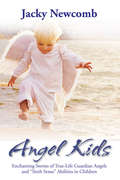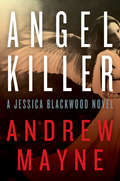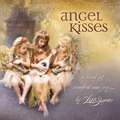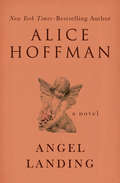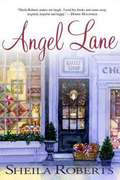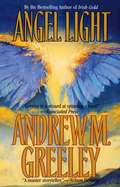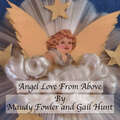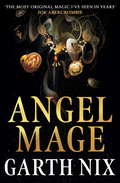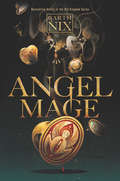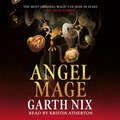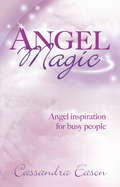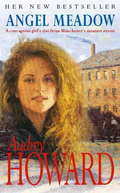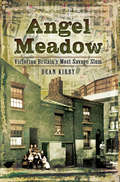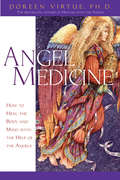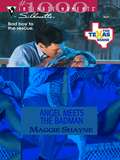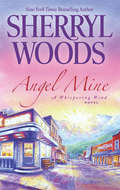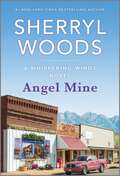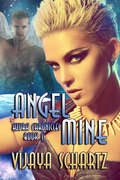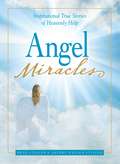- Table View
- List View
Angel Kids: Enchanting Stories Of True-life Guardian Angels And Sixth Sense Abilities In Children
by Jacky NewcombThis delightful book reveals the amazing encounters that children have with their guardian angels and loved ones on the Other Side, as well as fascinating insights into the lives of psychic children . . . and the parents who have to cope with this phenomenon. As you read, you’ll discover: • Grandparents who regularly visit their grandkids—from the Other Side! • Kids with extraordinary abilities, including mind-reading and the power to move objects with their thoughts alone • Young children who remember a life before they were born • The mother who lost a son who was later reborn as her grandson • The thousands of brilliant children whom the authorities have labeled as "learning disabled." Thousands of children the world over are being born with enhanced sixth-sense abilities. Psychic kids are the new "normal"!
Angel Killer: A Jessica Blackwood Novel (Jessica Blackwood Ser. #1)
by Andrew MayneFBI agent Jessica Blackwood believes she's left her complicated life as a gifted magician behind her . . . until a killer with seemingly supernatural powers puts her talents to the ultimate test.A hacker who identifies himself only as "Warlock" brings down the FBI's website and posts a code in its place that leads to a Michigan cemetery, where a dead girl is discovered rising from the ground . . . as if she tried to crawl out of her own grave.Born into a dynasty of illusionists, Jessica Blackwood is destined to become its next star--until she turns her back on her troubled family to begin a new life in law enforcement. But FBI consultant Dr. Jeffrey Ailes's discovery of an old magic magazine will turn Jessica's world upside down. Faced with a crime that appears beyond explanation, Ailes has nothing to lose--and everything to gain--by taking a chance on an agent raised in a world devoted to achieving the seemingly impossible.The body in the cemetery is only the first in the Warlock's series of dark miracles. Thrust into the media spotlight, with time ticking away until the next crime, can Jessica confront her past to stop a depraved killer? If she can't, she may become his next victim.
Angel Kisses: A Book of Comfort and Joy . . .
by Lisa JaneOne of America's foremost children's photographer helps you experience beauty and peace as you journey through life and the challenges it holds.Uplift your spirit and fill your heart with comfort and joy with this delightful collection of angelic artwork by world renowned artist/photographer Lisa Jane. By combining beautiful and intricately detailed child photography with inspirational writings, quotes, and Scriptures, Angel Kisses and its message of hope gives a small glimpse of heaven on earth, and reminds us all of His enormous and never-ending grace and love.
Angel Landing: A Novel
by Alice Hoffman&“A good, old-fashioned love story . . . Alice Hoffman&’s writing at its precise and heartbreaking best.&” —The Washington Post Things have changed in Fisher&’s Cove, the Long Island harbor town where Natalie spent her summers as a girl. The water used to be clean, and from her aunt Minnie&’s boarding house you could see all the way to Connecticut even on hazy days. Twenty years ago, Minnie never had a problem finding lodgers—but now everyone wants to be in Montauk or the Hamptons. The biggest change of all, though, is the nuclear power plant under construction on Angel Landing. Natalie&’s boyfriend, Carter, is leading a protest against the plant, and despite the fact that he is more devoted to his environmental work than he is to her, she has followed him to Fisher&’s Cove. During the days, she works as a therapist at a local counseling center; in the evenings, she ignores her aunt&’s disapproval as she waits for Carter to call. But after an explosion lights up the night sky above Angel Landing, Natalie&’s world is turned upside down. Into her office walks a man with an incredible confession to make, and the more she listens, the more Natalie begins to question the direction of her own life. The conclusions she draws—about passion, commitment, and what her heart truly wants—will lead her to a love she never imagined possible. Told with grace, charm, and wit, Angel Landing is a captivating romance and one of Alice Hoffman&’s most delightful novels.
Angel Lane
by Sheila RobertsKeep the heart in Heart Lake. That's exactly what three small-town shop owners hope to do when they launch their crazy-ambitious "Have a Heart" campaign--asking neighbors to commit one random act of kindness every day. Emma, Sarah, and Jamie love their lakeside community, but the little town is growing too big too fast, and a doing a good deed never hurt anyone. Or so they thought... When Emma slashes prices at her quilt shop, practically giving away blankets to anyone who looks vaguely cold, she almost stitches her way into bankruptcy. Sarah's free cooking class boils down to a hotbed of crime when some punk kid swipes her favorite heirloom. And at Jamie's chocolate shop, things take a bittersweet turn when a local policeman starts giving her grief, stirring up feelings she's tried to forget-and slowly melts away her defenses. . . With irresistible humor, warmth, affection- and recipes! -author Sheila Roberts serves up a generous, open-hearted story about the friendships we make, the chances we take, and the lives we touch every day.
Angel Light
by Andrew M. GreeleyAndrew M. Greeley's Angel Light is based on the Book of Tobis in the Old Testament, one of the sweetest love stories ever told. "I do not want ten million dollars. I do not want to visit Ireland. I do not want to end a Tobin family feud. And, above all, I do not want to court my eighth cousin, once removed." Even as he says the words, "Toby" Tobin, Irish-American computer hacker, knows it's useless to resist. His late great-uncle's will must be obeyed, and his family is determined to make him respectable by his twenty-fifth birthday.Encouraged by a photo of his cousin, Sara Anne Elizabeth Tobin, with her gorgeous black hair, blue eyes, and pale skin, Toby checks his computer for travel arrangements to Ireland. He finds himself chatting with an unusual travel agent, Raphaella, a very modern angel, who's been surfing the net for someone to look after.Raphaella gives him a new passport and first-class plane tickets out of O'Hare, and the encouragement and good humor he'll need on his quest for a living grail--the beautiful, mysterious, troubled, young Sara Tobin. He must marry Sara within the month (and solve an ancient mystery and elude a threatening thug) in order to claim his inheritance.At the Publisher's request, this title is being sold without Digital Rights Management Software (DRM) applied.
Angel Love From Above
by Maudy FowlerMaudy Fowler and Gail Hunt extend their heartfelt thanks to all of you for being such wonderful friends and supporters over the years. July 26, 2020, marked 20 years since Maudy and Gail first met. In celebration of this milestone, they have published seven globally recognized books, and now present this latest book for your enjoyment! This special book, created to commemorate their 20-year journey together, is filled with inspirational and empowering poetry, sayings, and photos designed to guide you through life’s journey. With their new book, Angel Love From Above, their goal is to remind everyone how special you are to them. They encourage you to: Live in the moment – live in the day. Pray, And let the Angels lead the way.
Angel Mage
by Garth NixMore than a century has passed since Liliath crept into the empty sarcophagus of Saint Marguerite, fleeing the Fall of Ystara. But she emerges from her magical sleep still beautiful, looking no more than nineteen, and once again renews her single-minded quest to be united with her lover, Palleniel, the archangel of Ystara. A seemingly impossible quest, but Liliath is one of the greatest practitioners of angelic magic to have ever lived, a genius at making icons to summon angels, and supremely adept in forcing them to do her bidding.Liliath already knew that most of the inhabitants of Ystara died from the Ash Blood plague or were transformed into beastlings, and she herself led the survivors who fled into neighbouring Sarance. Now she learns that angels shun the Ystaran's descendents. If they are touched by angelic magic, their blood will become ashes, or they will turn into beastlings. They are known as Refusers, and can only live the most lowly lives.But Liliath cares nothing for the descendants of her people, save how they can serve her. It is four young Sarancians who fix her interest, for they are the key to her quest: Simeon, a studious doctor-in-training; Henri, a dedicated fortune hunter; Agnez, an adventurous musketeer cadet; and Dorotea, an icon-maker and scholar of angelic magic. The four feel a strange, immediate kinship from the moment they meet, but do not know why, or suspect their importance. Only Liliath knows their secret, and she draws them in to her complex plot, just as she manipulates Queen Louisa and her musketeers; King Ferdinand and his guards; Cardinal Duplessis and her pursuivants; and the Refuser Night King Biscaray and his criminal gangs.All become pawns in Liliath's grand scheme to fulfill her destiny and be united with the love of her life. No matter the cost to everyone else.
Angel Mage
by Garth NixA new fantasy masterpiece from Garth Nix, bestselling author of the Old Kingdom series.More than a century has passed since Liliath crept into the empty sarcophagus of Saint Marguerite, fleeing the Fall of Ystara. <P><P>But she emerges from her magical sleep still beautiful, looking no more than nineteen, and once again renews her single-minded quest to be united with her lover, Palleniel, the archangel of Ystara.It's a seemingly impossible quest, but Liliath is one of the greatest practitioners of angelic magic to have ever lived, summoning angels and forcing them to do her bidding. <P><P>Four young people hold her interest: Simeon, a studious doctor-in-training; Henri, a dedicated fortune hunter; Agnez, a glory-seeking musketeer; and Dorotea, icon-maker and scholar of angelic magic.The four feel a strange kinship from the moment they meet but do not suspect their importance. And none of them know just how Liliath plans to use them, as mere pawns in her plan, no matter the cost to everyone else . . . <P><P>Fans of Cassandra Clare, Holly Black, and Leigh Bardugo will fall in love with Angel Mage, a feminist fantasy that takes place in an alternate European world ruled by fearsome magic and deadly passions.
Angel Mage
by Garth NixMore than a century has passed since Liliath crept into the empty sarcophagus of Saint Marguerite, fleeing the Fall of Ystara. But she emerges from her magical sleep still beautiful, looking no more than nineteen, and once again renews her single-minded quest to be united with her lover, Palleniel, the archangel of Ystara. A seemingly impossible quest, but Liliath is one of the greatest practitioners of angelic magic to have ever lived, a genius at making icons to summon angels, and supremely adept in forcing them to do her bidding.Liliath already knew that most of the inhabitants of Ystara died from the Ash Blood plague or were transformed into beastlings, and she herself led the survivors who fled into neighbouring Sarance. Now she learns that angels shun the Ystaran's descendents. If they are touched by angelic magic, their blood will become ashes, or they will turn into beastlings. They are known as Refusers, and can only live the most lowly lives.But Liliath cares nothing for the descendants of her people, save how they can serve her. It is four young Sarancians who fix her interest, for they are the key to her quest: Simeon, a studious doctor-in-training; Henri, a dedicated fortune hunter; Agnez, an adventurous musketeer cadet; and Dorotea, an icon-maker and scholar of angelic magic. The four feel a strange, immediate kinship from the moment they meet, but do not know why, or suspect their importance. Only Liliath knows their secret, and she draws them in to her complex plot, just as she manipulates Queen Louisa and her musketeers; King Ferdinand and his guards; Cardinal Duplessis and her pursuivants; and the Refuser Night King Biscaray and his criminal gangs.All become pawns in Liliath's grand scheme to fulfill her destiny and be united with the love of her life. No matter the cost to everyone else.
Angel Magic: Angel Inspiration for Busy People
by Cassandra EasonIn the frantic modern world many people want to discover easy ways to improve the harmony of their lives, reduce stress and resolve problems. ANGEL MAGIC is a delightful, user-friendly guide to angels for busy people, providing inspiration and guidance in an easily-accessible format. Based in ancient tradition, the power of angels can be used to benefit you in many different ways. Cassandra reveals: * Angels to guide and inspire in every aspect of your life including love, prosperity and career * Advice on how to contact specific angels for specific situations * Ways to work with angels for healing, protection and wellbeing* A list of 250 named angels, with explanations on how they relate to the modern world and the individual's needsThis delightful, user-friendly guide to angels also makes a perfect gift.
Angel Magic: Angel inspiration for busy people
by Cassandra EasonIn the frantic modern world many people want to discover easy ways to improve the harmony of their lives, reduce stress and resolve problems. ANGEL MAGIC is a delightful, user-friendly guide to angels for busy people, providing inspiration and guidance in an easily-accessible format. Based in ancient tradition, the power of angels can be used to benefit you in many different ways. Cassandra reveals: * Angels to guide and inspire in every aspect of your life including love, prosperity and career * Advice on how to contact specific angels for specific situations * Ways to work with angels for healing, protection and wellbeing* A list of 250 named angels, with explanations on how they relate to the modern world and the individual's needsThis delightful, user-friendly guide to angels also makes a perfect gift.
Angel Maker: The Short Stories of Sara Maitland
by Sara MaitlandWomen's lives are at the center of this stunning collection of short stories by the writer The New Yorker says "provides unexpected delights....Questions and answers alike shine with intelligence and an almost ninteenth-century concern for ideals."Though Sara Maitland's interests are as varied as the people who inhabit her stories, there is a common theme to this work that extols risk taking over safety. Acrobats, women warriors, a girl who wants to become a garden, a long-distance runner, housewives and mothers, and a reformed sixteenth-century conquistador are among the characters revealed in this dazzling collection.By turns elegant and simple, erotic and elegiac, the stories draw on classical mythology, folktales, inexplicable accidents of history, and disquieting experiences of the supernatural. And, as Ann Beattie has writen of Sara Maitland's wise and magical fiction, "it speaks to today's reader in a voice that is irresistible."Familiar names from literature--Gretel, Eurydice of the green fields, the shepherd Prince Endymion, Lady Artemis-commingle with contemporary characters called David, Meg, and Liz, who desperately seek love and fulfillment and frequently have babies when they can't get what they want. Close by is the echo of Mary Magdalene, teaching us about endurance and perserverance in a voice rich with the experiences of the sex object and the "true-love dichotomy." The author suggests: "She must have thought the crucifixion a bit mad too."Sara Maitland never holds back; instead, she invites us again and again to a place of risks, and we enter, "not because we must, but because we will." And when you are about to lose heart, you meet Caroline, who has learned what it is to be strong, how it feels to be free of fear, how it feels to be totally herself: "Then she looked at Richard and he was smiling, not pityingly, not even kindly, but with open admiration."
Angel Meadow
by Audrey HowardNancy Brody is different from the rest of the folk in Angel Meadow, the appalling slum where her drunken mother Kitty was a prostitute . . . Only nine years old, Nancy decides to save her sisters Mary and Rose from the workhouse. She gets work for them all at the Monarch Cotton Manufacturing Mill - and then sets out to better herself and her sisters. Saving every penny, working every waking hour, Nancy succeeds, becoming a manufacturer herself. But happiness seems as elusive for Nancy as it was when she was a mistreated child. Though he once said he loved her, Mick O'Rourke has become Nancy's worst enemy, and seems destined to take a terrible revenge on her and her sisters. And Josh Hayes, the man who truly loves Nancy, seems destined to be parted from her.
Angel Meadow
by Audrey HowardNancy Brody is different from the rest of the folk in Angel Meadow, the appalling slum where her drunken mother Kitty was a prostitute . . . Only nine years old, Nancy decides to save her sisters Mary and Rose from the workhouse. She gets work for them all at the Monarch Cotton Manufacturing Mill - and then sets out to better herself and her sisters. Saving every penny, working every waking hour, Nancy succeeds, becoming a manufacturer herself. But happiness seems as elusive for Nancy as it was when she was a mistreated child. Though he once said he loved her, Mick O'Rourke has become Nancy's worst enemy, and seems destined to take a terrible revenge on her and her sisters. And Josh Hayes, the man who truly loves Nancy, seems destined to be parted from her.
Angel Meadow: Victorian Britain's Most Savage Slum
by Dean Kirby“A record of how a city of great wealth ignored the desperate poverty at its very heart . . . It is a lesson in the price of capitalism.” —North West Labour History Journal“It is all free fighting here. Even some of the windows do not open, so it is useless to cry for help. Dampness and misery, violence and wrong, have left their handwriting in perfectly legible characters on the walls.” —Manchester Guardian, 1870Step into the Victorian underworld of Angel Meadow, the vilest and most dangerous slum of the Industrial Revolution. In the shadow of the world’s first cotton mill, 30,000 souls trapped by poverty are fighting for survival as the British Empire is built upon their backs. Thieves and prostitutes keep company with rats in overcrowded lodging houses and deep cellars on the banks of a black river, the Irk. Gangs of “scuttlers” stalk the streets in pointed, brass-tipped clogs. Those who evade their clutches are hunted down by cholera, typhoid and tuberculosis. Lawless drinking dens and a cold slab in the dead house provide the only relief from a filthy and frightening world.In this shocking book, journalist Dean Kirby takes readers on a hair-raising journey through the gin palaces, alleyways and underground vaults of this nineteenth-century Manchester slum considered so diabolical it was re-christened “hell upon earth” by Friedrich Engels.ENTER ANGEL MEADOW IF YOU DARE . . . “In this book the author expertly achieves driving home the grim horror that was Angel Meadow. These were conditions at the bottom of human endurance and conditions that go beyond imaginations of modern-day citizens.” —Crime Traveller
Angel Medicine: How To Heal The Body And Mind With The Help Of The Angels
by Doreen VirtuePart spiritual adventure story and part reference book. Angel Medicine is a three-part work that relates the exciting story of Doreen Virtue's recovery of memories of Atlantian healing methods along with messages from the Egyptian and Greek prophet and deity Hermes and the angels. The second and third parts of the book reveal the scientific studies, case studies, methods, and charts supporting the importance of love and light in healing.
Angel Meets the Badman
by Maggie ShayneTHE TAMING OF THE BAD BOYJake Nash had hoped his reputation would send her running right out of the bayou, because he knew damn well that a hardened ex-con like himself was the last thing a sweet little schoolteacher like Sara Brand needed.But she did need him. She needed him to ease the haunting memories and to keep her safe from the killer shadowing her. She needed the bad boy to be her hero. And he needed her, too-to show him that it didn't matter how bad he thought he was...because they could be oh, so good together.
Angel Mine
by Sherryl WoodsHeather Reed thought she was making the right choice when she decided to raise her daughter, Angel, on her own. But three years later, Heather realizes she needs help. Her career as an actress is faltering and Angel's more than she can handle alone. It's time to track down Angel's father.... THe only problem is he doesn't know Angel exists.Heather's search leads her to Whispering Winds, Wyoming. If Todd Winston is dismayed to see his old girlfriend show up in town, he's horrified when he looks into the angelic eyes of the little girl who is clearly his daughter.Todd flatly refuses to open his life to Angel...and Heather flatly refuses to leave town until she finds out why.Neither counts, though, on their unexpected desire to become a family. The only question is...is it too late?
Angel Mine (Whispering Wind #2)
by Sherryl WoodsFrom the bestselling author behind the hit Sweet Magnolias Netflix seriesIn this charming small-town tale from #1 New York Times bestselling author Sherryl Woods, readers revisit the peaceful Whispering Wind Ranch, where one woman journeys to rediscover the meaning of love, friendship, and family.Heather Reed thought she was making the right choice when she decided to raise her daughter, Angel, on her own. But three years later, Heather realizes she needs help. Her career as an actress is faltering, and Angel's more than she can handle alone. It's time to track down Angel's father… only problem is, he doesn't know Angel exists.Heather's search leads her to Whispering Wind, Wyoming. If Todd Winston is dismayed to see his old girlfriend show up in town, he's shocked when he looks into the angelic eyes of the little girl who is clearly his daughter. Todd flatly refuses to open his life to Angel. Heather flatly refuses to leave town until she finds out why. Amazingly, they discover that through compromise and understanding lies the road straight to family.Books in the Whispering Wind duology:After TexAngel MinePreviously published.
Angel Mine: Azura Chronicles (Azura Chronicles #1)
by Vijaya SchartzWhat in the frozen hells of Laxxar prompted Fianna to pursue her quarry to this forbidden blue planet? Well, she needs the credits... badly. But as if crashing in the jungle wasn't bad enough, none of her high-tech weapons work. She'll have to go native, after the most wanted felon in five galaxies. It's not just her job. It's personal. <P><P>Acielon has never seen an outworlder like this fascinating female, strangely beautiful, and fierce, like the feline predator loping at her side. He always dreamed of exploring the universe, despite the legends... and the interdiction. Is it truly a hellish place of violence, lies and suffering? If it spawned this intriguing creature, it must also be a place of wonders, adventure and excitement. <P><P>Fianna's instincts tell her someone is watching. Sheba, her telepathic feline partner, doesn't seem worried... yet, something on Azura isn't quite right.
Angel Miracles
by Brad Steiger Sherry Hansen SteigerA near collision while driving. Recovery from a serious illness. Escaping an accident without a scratch. Everyone has had a moment when they knew someone up above was looking out for them down below. Some things are just unexplainable. Sometimes it has to be left to one's Guardian Angel. This book is a collection of stories that shine with hope and true inspiration. Compiled by Brad Steiger and Sherry Hansen Steiger, it celebrates the beauty of mysterious miracles that can only be attributed to those divine helpers. You will be astonished by these remarkably true stories of angelic intervention.
Angel Miracles
by Brad Steiger Sherry Hansen SteigerA near collision while driving. Recovery from a serious illness. Escaping an accident without a scratch. Everyone has had a moment when they knew someone up above was looking out for them down below. Some things are just unexplainable. Sometimes it has to be left to one's Guardian Angel. This book is a collection of stories that shine with hope and true inspiration. Compiled by Brad Steiger and Sherry Hansen Steiger, it celebrates the beauty of mysterious miracles that can only be attributed to those divine helpers. Readers will be astonished by these remarkably true stories of angelic intervention.
Angel Miracles: Inspirational True Stories of Heavenly Help
by Brad SteigerA near collision while driving. Recovery from a serious illness. Escaping an accident without a scratch. Everyone has had a moment when they knew someone up above was looking out for them down below. Some things are just unexplainable. Sometimes it has to be left to one's Guardian Angel. This book is a collection of stories that shine with hope and true inspiration. Compiled by Brad Steiger and Sherry Hansen Steiger, it celebrates the beauty of mysterious miracles that can only be attributed to those divine helpers. You will be astonished by these remarkably true stories of angelic intervention.
